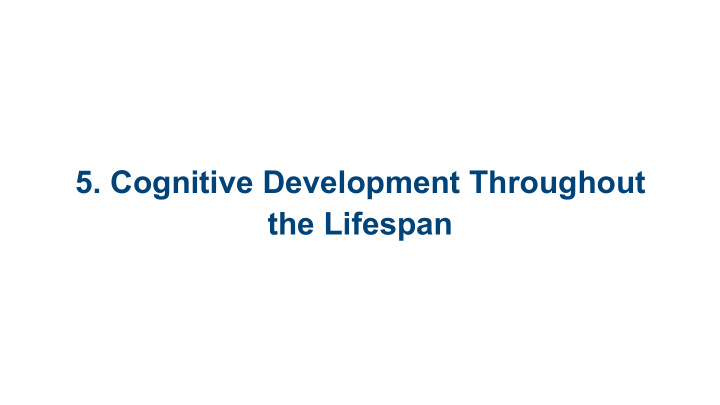



5. Cognitive Development Throughout the Lifespan
5.1 Thinking 5.2 Piaget’s Cognitive Development Theory 5.3 Vygotsky’s Sociocultural Theory
5.4 Play 5.5 Information Processing 5.6 Executive Function
5.7 Attention 5.8 Memory 5.9 Problem Solving and Planning
5.10 Environmental Influences 5.11 Expertise 5.12 Wisdom
5.1 Thinking
Thinking and its development • Thinking differences infant to child to teen to adult • How/when do changes occur? • What can/can’t be thought at different ages?
5.2 Piaget’s Cognitive Development Theory
Piaget: observing child thinking/acting • Before cognitive science, but mostly accurate • Stages/ages with distinct thinking traits • Should show up across cultures
Piaget: First model • Schema = concept or category of information • Disequilibrium = new facts don’t match schema • Adaptation (reorganize) Accommodate (modify) Assimilate (incorporate) ➔ New equilibrium
Piaget: Example • Schema: DOG = small, furry • Disequilibrium: Say “DOG” parent says, “No, CAT”
Piaget: Example • Adaptation Accommodation: Some small, furry are not dogs Assimilation: Create new CAT schema ➔ New equilibrium achieved
Sensorimotor stage (0-2) Characteristics & challenges • Senses and manipulation • Focus and intention • Object permanence • Imitation • “Random” explorations and experimentation
Preoperational (2-7) • Centration (can filter only 1 attribute out of many), so not able to understand • Conservation of quantity • Reversibility of operations • Egocentric viewpoint • From “my” perspective • Animism (“Ball is sad”)
Preoperational (2-7) • “Play” as primary learning mode • Language acquisition • Also time of mastering gender identity/stability
Concrete operations (7-11) • Mastery of previous challenges • Less egocentric • Logical reasoning • Classification (by attribute) • Seriation (sequencing)
Formal operations (11-) • Abstract reasoning • Literary symbols • Ideological implications • Quantitative concepts (higher math, geometry) • Hypothetical reasoning • Generate hypotheses • Idealization
5.3 Vygotsky’s Sociocultural Theory
Vygotsky: Social learning • Internalization = soaking up environment (learning) through interaction with others • Observation and imitation central to learning
Scaffolded learning • Parent/sibling/teacher assesses zone of proximal development (gap in skills or knowledge) • “Teacher” sets up mediated learning experiences • Sets environment to fill in gap sequentially
5.4 Play
Play: child’s work • Fits Piaget and Vygotsky • Stages of play: • Solitary • Parallel • Cooperative • Types of play: • Constructive • Symbolic/pretend
5.5 Executive Function
Executive function • All brain processes that affect learning/behavior • Examples: control of attention, memory • Early childhood (2-5): • Inhibitory control (block impulses) • Working (temporary) memory
Executive function • Middle childhood (6-12): • Verbal working memory • Plan/organize • Cognitive flexibility • Adolescence: • Strong improvement of all previous
Executive function • Adulthood: • Myelination in prefrontal cortex for maximum cognitive ability (peak 20-29) • Decline in memory in later adulthood • Cognitive flexibility starts declining age 70
5.6 Information Processing
Cognitive science brain models • Explain how executive function works • How stimuli “out there” ➔ useable knowledge • Memory processes: • Attend (focus) • Encode (retain) • Retrieve (recall)
5.7 Attention
Attention Act of focusing/filtering sensory input • Sensory input is constant, changing, and vast • From earliest age, brain learns to filter and attend to small portion of input
5.8 Memory
Working memory (aka “short-term memory”) • Like computer RAM (temporary storage before processing) • Capable of storing few bits of information • Size of bits can be enlarged by chunking
Rehearsal Prevent loss of working memory contents • Maintenance rehearsal = rote/repetition • Elaborative rehearsal = encoding by activity or by relating to previous knowledge
Long-term memory Like computer storage • Semantic = facts and information • Episodic = experiences and events • Procedural = “how-to”
Schemata (plural) Organizational metaphor • Like folders on computer screen to show contents • Schema = concept or category (e.g. “dog”) [like document folder] • Subschema = sub- category [folder in folder]
5.9 Problem Solving and Planning
Problem-solving ability • Related to developing prefrontal cortex and myelin sheathing • Ability in childhood, big increase in adolescence, more in early adulthood
Synthesizing memory for new situations • Brainstorming (idealizing and rearranging memory) • Creating/using heuristics (general rule, mental map) • Ability to work backward from goal
5.10 Environmental Influences
Cognitive influencers • Long-term stress (family, SES, events) • Affects brain structure development • Affects hormone balance brain/body • Culture & gender • Expectations mold cognitive functions
5.11 Expertise
10,000 Hours = 10 years • Expertise: know, apply, analyze, and synthesize • Associated with middle adulthood ➔ peak of knowledge/ability • Good for promotion, mentoring, or entrepreneurship
5.12 Wisdom
Wisdom of age? • Associated with late adulthood (but not all) • Self-awareness, emotional stability, appropriate word/ action • Understanding and empathy • From helping and leading others
Recommend
More recommend